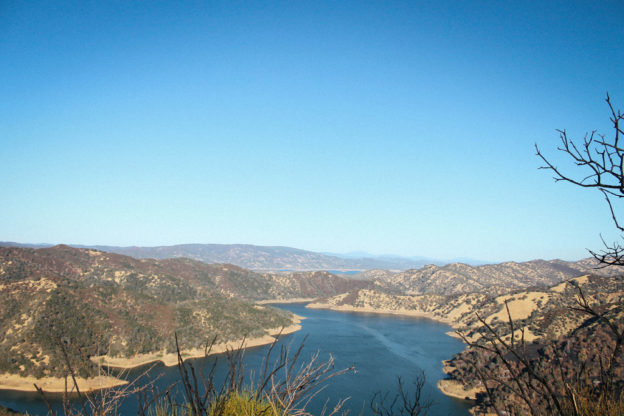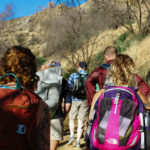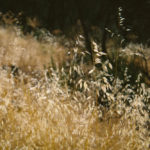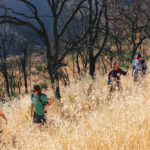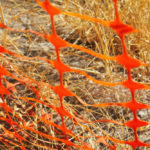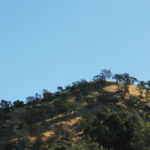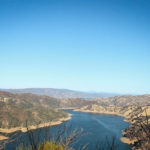Reporter Marie Orttenburger attended the “Mercury Pollution, Wildfire and Fault Line Impacts on Lake Berryessa” tour at the Society of Environmental Journalists 26th Annual Conference. This podcast is her reflection on the experience.
Transcript
I’m Marie Orttenburger. I recently traveled to Sacramento for the Society of Environmental Journalist’s 26th annual conference. Part of what’s cool about the conference is its inclusion of tours of the host location. You pick the trip most akin to your interests — based either on subject matter or how you’d like to spend your day.
I ended up selecting one because it included a morning mountain hike followed by lunch overlooking a lake. The hike was the “difficult”-rated Homestead-Blue Ridge Trail and the lake was Lake Berryessa, located in the Stebbins Cold Canyon Natural Reserve in California’s Napa County. The reserve is coping with the polluted legacy of gold and mercury mining in the region, as well as the recovering from a slew of human-caused fires. The hike invited us to observe the landscape while learning of its tribulations, both visible and otherwise.
The tour bus was set for a 6:30 a.m. departure. Our small group groggily loaded in, equipped with hiking boots and sun hats. We watched the sunrise paint the sky with a pinkish gradient as we drove westward.
When we arrived at the trailhead, the sun was not yet high enough to warm the landscape. We shivered as we shared introductions, but before long we were ascending steep inclines, and we warmed up quickly.
As we walked, Bob Schneider shared some of the challenges of managing the trail. Schneider is the Senior Policy Director of Tuleyome, a non-profit conservation organization largely responsible for Lake Berryessa Snow Mountain’s declaration as a national monument last year.
“The erosion mats are down here and this fencing’s here, and the effort is to try and restore this hillside. Because people used to cut down to the trail down here, sliding down on their butts, and it just created a real erosion problem,” Schneider said.
“I told the [Stebbins Cold Canyon Natural] Reserve people you should be planting poison oak here, but I don’t know if it’ll grow in the sunshine here.”
The region is healing. It’s endured yearly human-caused wildfires since 2014, each wiping out already drought-weakened trees.
Some recent efforts from Tuleyome are focusing on helping the region heal from damage as old as California’s gold rush.
The landscape surrounding Lake Berryessa is dotted with cinnabar deposits. Cinnabar is a reddish-brown ore that, when refined, becomes “quicksilver,” or liquid mercury.
Those deposits were mined first in the 1850s. At that time, the mercury was being used for mining gold. If you’re like me, you might ask, what could a bearded prospector with a pickaxe need mercury for?
Well it turns out that wasn’t the only way gold was mined. Stephen McCord, the president of McCord Environmental and a collaborator on Tuleyome’s Mercury Mine Remediation Program, told us more about that when we reached the peak of our hike. We took in the golden hills framing the massive Lake Berryessa as he spoke.
“The largest scale mining was called hydraulic mining. So they divert water, and like a firefighter with a big hose, they’d wash off an entire mountainside, which just had very fine flakes of gold. to wash of something of that scale, they’d run all that muddy slurry through these sluices with mercury at the bottom, and the gold, also very dense, would settle out and stay in the mercury. They’d run it out for a day or two, cut it off, burn off the mercury and the gold would stay behind,” McCord said.
So, you know, really environmentally sound practices.
The mercury mined in the Lake Berryessa region was used to mine gold in the Sierra Nevada. The technique, though long since abandoned, continues to poison water in both regions.
“Whenever I’m talking with my Sierra friends, I have to apologize, because not only did [the miners] pollute our watersheds, they polluted all theirs,” Schneider joked.
Mercury mining continued throughout the 1970s. The mercury was used in ammunition for World Wars I and II and then for hearing aids.
The degree to which the abandoned mines harm surrounding ecosystems varies, and accordingly, so do Tuleyome’s remediation efforts. Certain areas call for filling in gaping holes in the landscape, others for planting foliage to help filter mercury from water that flows into the watershed. But the primary area of concern is with the organisms who bioaccumulate the mercury that settles in reservoirs. McCord explained what that means:
“The levels in predatory fish, they’ve accumulated from the little fish that they eat, which accumulated from the bugs they eat, which have accumulated from the algae they eat, and the levels in fish are about 10 million fold higher, 10 million times more concentrated in the fish” McCord said. “And one of the interesting things about the bioaccumulation process is that it’s not the same for all fish. It depends on what the fish are eating, how big the fish are, different species have different habitats.”
Eating too much mercury-contaminated fish can cause a variety of health problems, and it is especially dangerous for women who are pregnant or breastfeeding, so outreach is important. The process of informing the public about which fish are safe to eat is a bit clunky, McCord said. The California Office of Environmental Health Hazard Assessment issues advisories for water systems that a different agency has designated as “impaired” by mercury. The advisories in a given area identify which species are and are not safe to eat. There can be some inconsistency in how specific the advisories are, and cultural differences contribute to confusion.
And on that incomplete-feeling note, we began our descent.
The walk back was perfectly pleasant. We wound our way down the trail, skirting poison oak. The sun was higher, but not yet unbearably hot. The views were just as good the second time around.
I’m a Michigander, unfamiliar with the countenance of drought and its influence on the Lake Berryessa landscape. I have no memory of the trees and grasses that once thrived there. I can’t see the mercury, or how it seeps into the waterways and the bellies of fish. I can only behold the sprawling, hilly, golden picture as something alien and beautiful.
But it struggles. And there are legions of people quietly trying to heal its wounds, fresh and ages old.
- Hikers ascending the mountain.
- We were rewarded with these kinds of views throughout the hike.
- Wild oats are an invasive grass that came over when the Spanish settled California. They cover the hills.
- Tour leaders Lindsey Hoshaw and Bob Schneider.
- Hikers in the wild oats.
- Fencing and mesh are installed to keep hikers off areas susceptible to erosion.
- Blue oaks dot this golden hill.
- The top of the Blue Ridge Loop lends a beautiful panorama overlooking Lake Berryessa.

